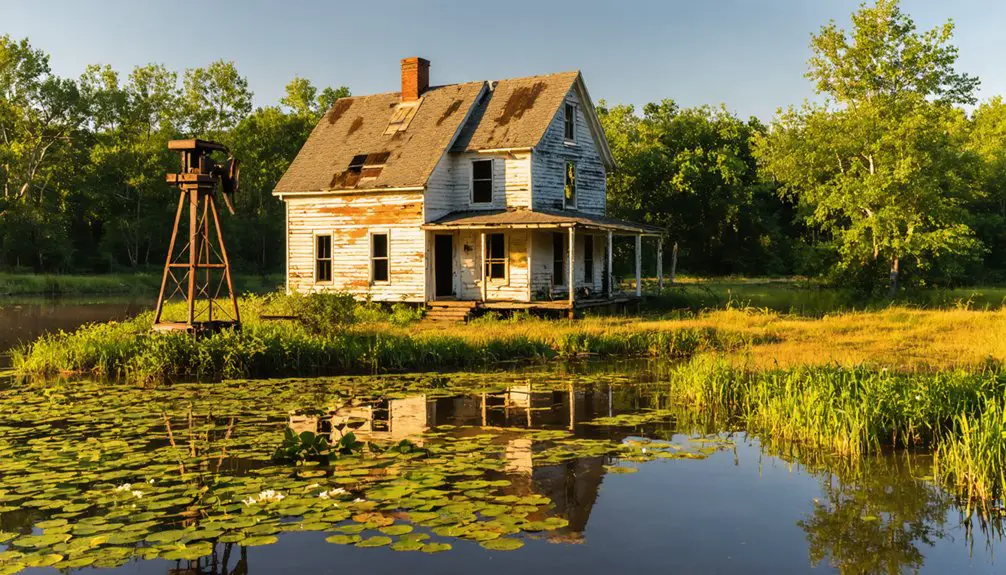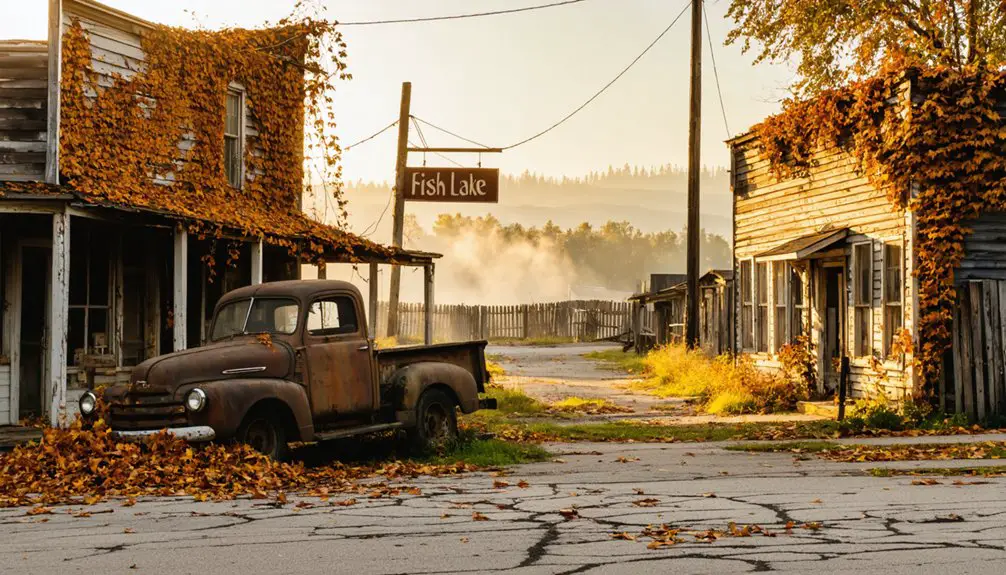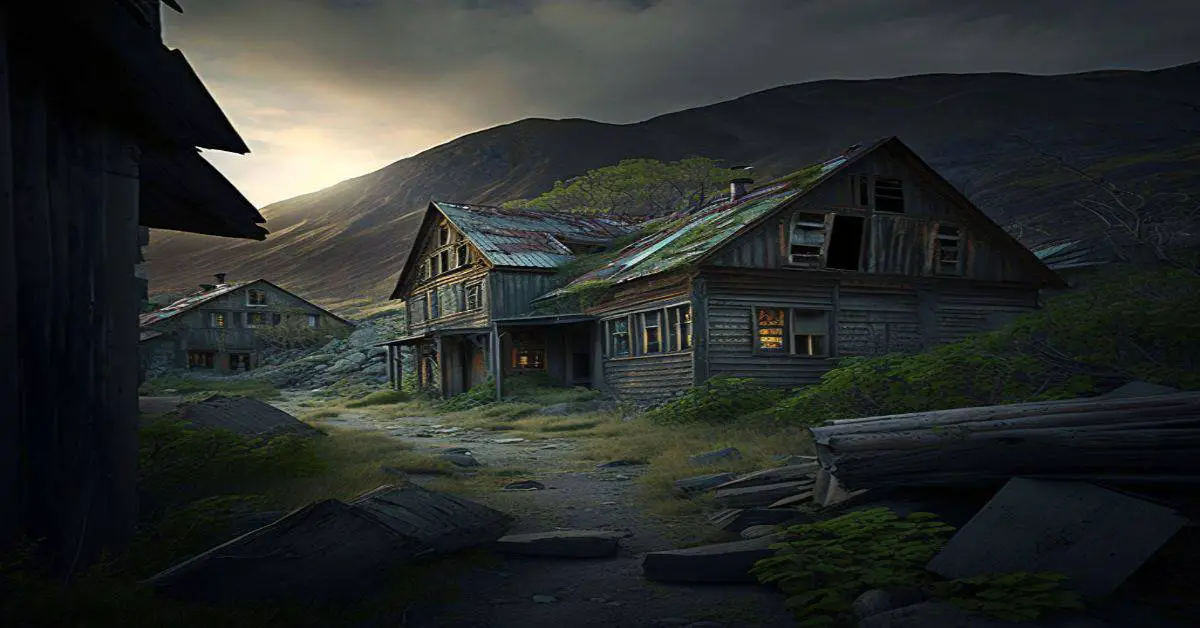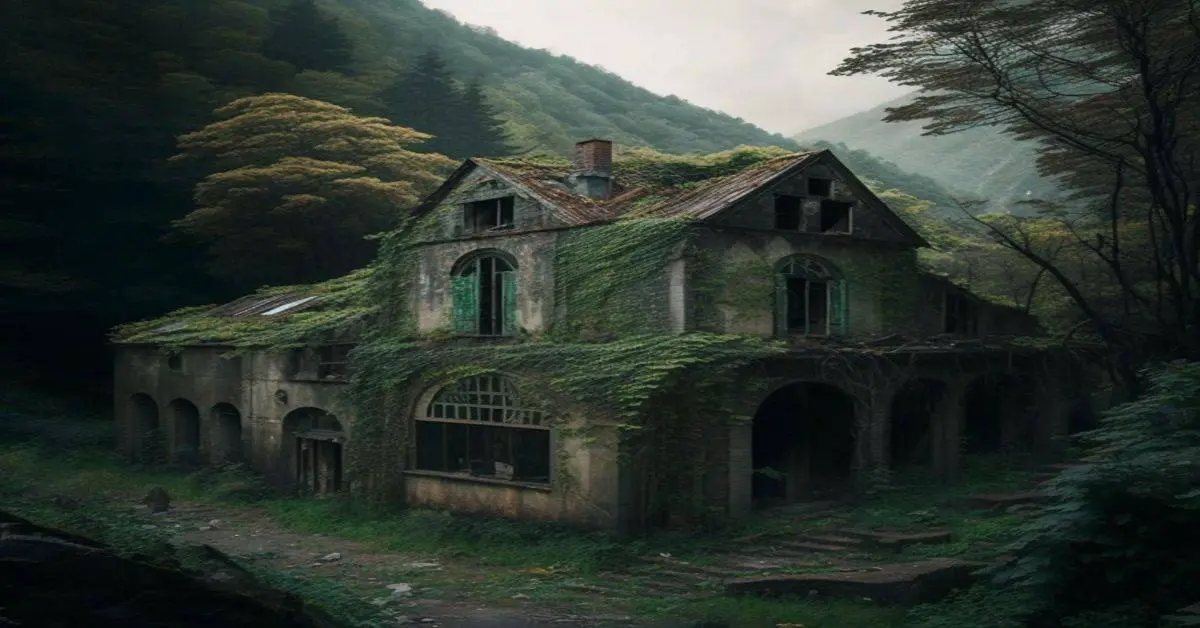You’ll find Fish Lake’s remnants in Michigan, where a bustling lumber town of 2,000 residents once thrived between 1840-1870. The community centered around sawmills, developed by founding families like the Mitchells and lumber barons Butters and Peters. Finnish, Swedish, and Norwegian immigrants worked the mills until unsustainable logging practices led to closure. After the final mill shut down in 1932, nature reclaimed the 600-acre settlement, leaving traces of this boom-and-bust story beneath the wilderness.
Key Takeaways
- Fish Lake thrived during Michigan’s lumber boom (1840-1870) before becoming a ghost town due to unsustainable logging practices.
- The town covered 600 acres with 142 blocks, featuring churches, schools, and a prominent fish market at its peak.
- Economic decline began with mill closures in the early 1900s, followed by commercial fishing’s collapse in the 1930s.
- Families abandoned the settlement, dismantling homes and leaving behind vacant streets and industrial equipment.
- Natural reclamation and dam-created reservoirs submerged parts of the town, leaving minimal surface evidence of its existence today.
The Rise of a Lumber Empire
As Michigan’s lumber industry exploded between 1840 and 1870, Fish Lake emerged as part of the state’s transformation into America’s leading timber producer.
Michigan’s lumber boom of 1840-1870 transformed Fish Lake into a vital part of the nation’s dominant timber industry.
You’d have witnessed a flurry of activity as lumber transportation methods evolved, from traditional river drives to innovative “big wheels” invented by Cyrus Overpack that could move logs regardless of weather conditions.
The region’s natural waterways proved essential, with networks of creeks and streams carrying white pine logs to bustling mills. The Charlevoix Lumber Company established itself in 1876 as a major operation, surviving well past the industry decline around 1915.
Logging innovations like specialized “lumber hooker” ships helped transport finished products across the Great Lakes to growing markets. After the last mill closed in 1932, a shift occurred with local workers returning to fishing and lumbering activities.
Around Fish Lake, commercial logging companies rapidly organized as profits soared, bringing eastern capital and labor while developing unique regional techniques.
The town’s strategic location amid Michigan’s rich pine forests positioned it perfectly within this booming timber empire.
Daily Life in Early Fish Lake
Life in early Fish Lake revolved around the rhythms of its abundant waters. You’d find families engaged in seasonal fishing, moving between summer shoreline spots and sheltered winter locations. The community relied heavily on stone weir traps to secure their daily catch.
The community’s cultural practices centered on fishing activities, with skills and knowledge passed down through generations. In particular, tribes like the Chippewa and Ottawa established enduring night fishing traditions that shaped the community’s practices. You would’ve seen villagers crafting gill nets from natural materials and working together to suspend nets between canoes.
At night, they’d take advantage of fish attracted to light sources. The daily routine included preserving catches through smoking and drying to guarantee food security during lean months.
As European settlers arrived in the region, you’d notice the community adapting their traditional methods, incorporating new materials and expanding their trade networks while maintaining their deep connection to the lake’s ecosystem.
Architecture and Infrastructure
You’ll find Fish Lake’s architectural legacy most evident in its wood-frame buildings and extensive dock system, including the impressive 900-foot dock that served the town’s bustling harbor.
The community’s infrastructure centered around key facilities like the four-story grain elevator and strategically placed icehouses, which could sustain up to 1,000 residents through harsh winters. Much like a disambiguation page, the town’s layout helped visitors navigate efficiently to their intended destinations.
The steam powered machine shop maintained all the town’s industrial equipment. The town’s layout reflected both practicality and social organization, with worker housing clustered near industrial sites while schools, churches, and the post office formed the community’s core.
Building Materials and Methods
While many frontier towns relied on basic construction methods, Fish Lake’s early settlers employed both innovative pre-fabricated housing and traditional timber building techniques.
You’d find temporary shelters made from hemlock branches and locally harvested timber, which settlers used until they could establish more permanent structures. These makeshift dwellings often resembled animal dens, built low to the ground for protection during harsh winters.
Community construction efforts focused on creating essential infrastructure using wood from local sawmills. Buildings were frequently plastered for improved durability, with some featuring modern amenities like indoor plumbing powered by sawdust burners. After initial investments in construction, the town faced challenges when wildcat banks failed in 1837.
The town’s development included pre-built housing sections arranged on planned city blocks, though these ambitious construction projects often faced challenges from financial instability and environmental conditions.
Surviving Structural Elements
Standing as silent witnesses to Fish Lake’s industrial past, numerous structural elements survive across the former settlement site. The settlement thrived with a peak population of about 500 residents.
You’ll find the imposing stone blast furnace near the bay shore, with its surviving foundations and masonry remnants telling the story of the town’s smelting operations.
Along the waterfront, weathered stone retaining walls and dock pilings stretch for hundreds of feet, marking where ships once loaded and unloaded cargo. Similar to Clark Lake, divers have discovered sunken boats and sleds scattered across the lakebed.
The wooden structures that remain include partial walls of workers’ homes, commercial buildings, and reconstructed cabins built from salvaged materials.
Near the shoreline, industrial equipment foundations reveal where massive machinery once stood, while iron components and slag heaps scatter the grounds.
Stone chimneys and furnace elements stand as stark reminders of Fish Lake’s once-bustling industrial community.
Town Layout Design
During its ambitious development phase, Fish Lake’s planners laid out an expansive 600-acre settlement divided into 142 blocks, with each block containing 24 uniform lots. The thorough land use plan integrated residential, commercial, and civic spaces, creating an efficient community design that supported diverse activities. Unfortunately, like Port Sheldon Company, the development faced financial ruin.
You’ll find the town was thoughtfully organized with an extensive infrastructure network, including streets, sidewalks, and a two-mile railroad connection. Central to the layout were critical amenities like churches, schools, and a fish market.
The $40,000 Ottawa House hotel served as a prominent architectural anchor, while pre-fabricated homes provided practical housing solutions. The waterfront area featured purpose-built structures including a pier, lighthouse, and yacht docking facilities, maximizing the town’s connection to Fish Lake while supporting shipping and fishing operations.
Notable Figures and Families

As Fish Lake’s early development took shape, Alex Joudon emerged as a pivotal figure after arriving from Pennsylvania in 1835. He gathered wealthy investors to form the Port Sheldon Land Company, aiming to create a thriving city with extensive infrastructure.
However, the founding families’ ambitious plans crumbled during the 1837 banking crisis.
The Mitchell brothers wielded significant economic influence as major landowners, while lumber barons Horace Butters and Richard Peters controlled the region’s timber operations.
Finnish, Swedish, and Norwegian immigrants provided the essential workforce, with Finns operating mills and Scandinavians managing forest logging. These immigrant families established lasting community institutions, including churches and schools, though many founding families eventually relocated as the town declined.
The Mitchell family notably moved numerous homes to Cadillac, seeking better opportunities elsewhere.
The Turning Point: Economic Decline
If you’d visited Fish Lake in its prime, you’d have seen bustling sawmills employing much of the local workforce until unsustainable logging practices stripped the surrounding forests bare.
The closure of these mills in the early 20th century forced skilled workers to seek opportunities in neighboring towns with more diverse economies.
As families relocated for work, they often dismantled and moved their homes, leaving behind increasingly vacant streets and abandoned industrial equipment.
Mill Closures Impact Community
The closure of Fish Lake’s final copper stamp mill in 1932 marked a devastating turning point for the community’s economy.
You’d have witnessed widespread job losses and a sharp population decline as families sought opportunities elsewhere. While some workers demonstrated community resilience by adapting to fishing and logging industries, these alternatives couldn’t match the economic power of the mills.
The Dion Sawmill offered hope by employing 20-25 workers through the 1960s, showing economic adaptation in action.
Yet the community faced mounting challenges as rail service reductions threatened even this foothold. Environmental damage from mill operations left a lasting legacy, with mercury contamination and debris cluttering local waterways.
While cleanup efforts removed over 300,600 metric tons of waste, the social fabric had already fundamentally changed, weakening cultural institutions and forcing younger generations to leave.
Workforce Migration Patterns
Beyond the mill closures, Fish Lake’s workforce experienced dramatic shifts in the 1930s as traditional industries crumbled.
Major workforce trends showed commercial fishermen leaving as fish stocks declined due to invasive species and pollution. You’d have seen young workers particularly abandoning traditional fishing roles, seeking employment in urban manufacturing or tourism-based services.
The migration causes were clear – falling fish prices and catch limits strained the commercial fishing industry’s sustainability.
As the region’s economic focus evolved toward recreational fishing and tourism, which generated billions in revenue statewide, workers had to adapt or relocate.
You’ll find this change marked a permanent change in Fish Lake’s identity, as fishing families dispersed and traditional skills became less economically viable, ultimately weakening the community’s social fabric.
Natural Reclamation and Present State
Over decades of abandonment, Fish Lake’s former townsite underwent dramatic transformation through both natural reclamation and artificial flooding.
You’ll find the area has experienced significant natural restoration, as native vegetation gradually reclaimed the once-cleared land. The ecological evolution includes dense forest cover that’s now obscuring old foundations and roads.
- Dam construction created reservoirs that submerged portions of the former settlement beneath water and silt
- Natural reforestation has attracted diverse wildlife back to the area, creating new habitats
- Surface evidence of the town is minimal due to sedimentation and vegetative overgrowth
- While the site itself may be difficult to access, nearby roads sometimes feature historical markers
Today, you’re more likely to encounter a thriving ecosystem than remnants of the ghost town, as nature has largely reclaimed this piece of Michigan’s past.
Legacy in Michigan’s History
While nature has absorbed Fish Lake‘s physical traces, its role in Michigan’s history endures as a compelling example of 19th-century boom-and-bust settlement patterns. You’ll find its story woven into the larger tapestry of Michigan’s ghost towns, where ambitious dreams met harsh economic realities.
Fish Lake’s cultural heritage reflects the determination of immigrant settlers who transformed the wilderness into a bustling logging community. Finnish, Swedish, Norwegian, and Bohemian immigrant stories come alive through the remnants of churches, schools, and mill operations they established.
Today, you can explore this legacy through heritage tourism sites, where historical societies work to preserve the memories of these frontier communities. Like many Michigan ghost towns, Fish Lake serves as a powerful reminder of how resource-dependent economies shaped the state’s development and eventual shift toward urban centers.
Frequently Asked Questions
Are There Any Haunted Locations or Ghost Stories Associated With Fish Lake?
Among Michigan’s 130+ ghost towns, you won’t find documented haunted tales or ghost sightings at Fish Lake. While the town’s abandonment sparks curiosity, no verified paranormal activity exists in historical records.
What Wildlife Species Have Returned to the Abandoned Town Site?
You’ll spot increasing wildlife sightings throughout the rewilded area, including white-tailed deer, coyotes, black bears, herons, eagles, and beavers, showcasing remarkable species diversity since human abandonment.
Can Visitors Legally Explore the Remaining Structures at Fish Lake?
Patiently perched properties require private permission. You can’t legally explore remaining structures without landowner approval or official authorization. Follow visitor guidelines to avoid trespassing fines while preserving historic sites.
Were Any Artifacts or Valuable Items Discovered After the Town’s Abandonment?
You won’t find documented artifact discoveries or valuable relics from this abandoned town. While Lake Michigan’s region has rich archaeological finds, there’s no public record of treasures from this specific site.
Did Any Disasters, Accidents, or Tragic Events Occur in Fish Lake?
You’ll find records of several tragic events, including natural disasters like the 1967 storm that capsized 150 boats, causing eight deaths, and historical accidents involving chemical contamination from nearby industrial plants.
References
- https://99wfmk.com/one-of-michigans-first-ghost-towns/
- https://witl.com/one-of-michigans-first-ghost-towns/
- https://www.nps.gov/slbe/learn/historyculture/ghosttowns.htm
- https://www.nailhed.com/2017/10/the-ghost-town-that-moved.html
- https://www.audacy.com/wwjnewsradio/news/local/best-of-the-daily-j-the-story-of-singapore-michigans-buried-ghost-town
- https://msaf.forest.mtu.edu/ForestInfo/MSUElibrary/LumberingInMichigan.PDF
- https://www.nps.gov/piro/learn/historyculture/logging-history.htm
- https://www.hmdb.org/m.asp?m=215844
- https://www.hrwc.org/wp-content/uploads/2014/02/Michigan-Fisheries_-200-years.pdf
- https://keweenawhistory.org/fishing-and-lumbering


